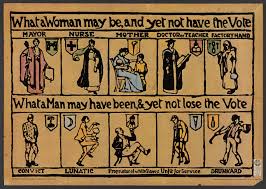
Since the publication of Mary Wollstonecraft’s feminist text, Vindication of the Rights of Woman (1792), the women’s movement in Britain had grown exponentially. In the 1830s, the women’s movement turned their attention to women’s suffrage, with various groups dedicated to enfranchisement forming by the 1860s. The inability to vote meant women had few rights in comparison to men. As a result, the vote quickly became a symbol of civil and gender inequality that impassioned Victorian women across Britain. Groups such as the Women’s Social and Political Union (WSPU) and the Artist Suffrage League (1907) relentlessly signed petitions, made speeches, held public demonstrations, and published feminist pictorial propaganda in journals and newspapers to garner support for the cause. Drawing inspiration from these groups, feminist author Clemence Housman and her brother Laurence, established the Suffrage Atelier in 1909, setting up headquarters in their small Kensington home. Led by Clemence, the Atelier produced visual feminist propaganda and encouraged artists to create work to feature in various publications. Clemence compensated her artists with a percentage of the profits generated by sold artwork and tirelessly used her skills as an embroider, illustrator, and wood engraver to produce many of the group’s visual banners. The group also ran numerous printmaking workshops and attended political exhibitions and rallies, where Clemence and other members circulated the group's artwork. During the Atelier’s five-year run, Clemence successfully united women of various classes and backgrounds to aid in the suffrage movement. Her work with the Atelier truly highlights her dedication to women’s rights and the fight against strict gender constraints that governed Victorian women. Her passion for women’s rights is present in different facets of her life, including her feminist text, The Were-Wolf.
Sources Used:
https://www.bl.uk/votes-for-women/articles/the-campaign-for-womens-suffrage-an-introduction
http://www.victorianweb.org/history/wmhisttl.html
https://editions.covecollective.org/content/road-womens-suffrage-timeline
https://www.tandfonline.com/doi/abs/10.1080/09612025.2012.658177
